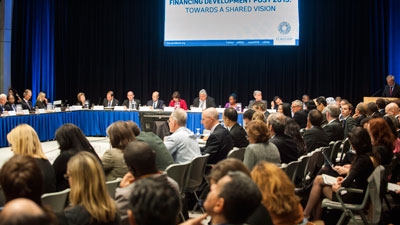The 2014 IMF-World Bank Group Annual Meetings provided the perfect opportunity for finance and development ministers, the private sector, civil society, and multilateral development banks (MDBs) to discuss how to strengthen and leverage their financing frameworks to support the post-2015 agenda, also known as the Sustainable Development Goals (SDGs).
With world leaders set to meet in September 2015 to agree on a set of goals to replace the Millennium Development Goals (MDGs), a great deal of energy is being spent deliberating on what the new goals should be. However, with the recent announcement of the Third International Conference on Financing for Development in July 2015 in Addis Ababa, world leaders have also started turning their attention to the critical matter of how to finance the post-2015 agenda.
The SDGs will be more ambitious than the MDGs, covering a broad range of interconnected issues, from economic growth to social issues to global public goods. To realize this vision, a just-as-ambitious plan for financing and implementation is needed. The magnitude of the SDG financing challenge far exceeds the capacity of any one organization and demands a strong partnership between governments, the private sector, and development organizations.
The flagship event, moderated by Mahmoud Mohieldin, corporate secretary and special envoy of the president at the World Bank, took place Oct. 10. It delivered a powerful message to development stakeholders: The MDBs are committed to working together to break new ground on financing for development issues. These include helping improve domestic resource mobilization, leveraging private investment, financing global public goods, providing long-term finance, and linking climate and development finance.
Government, private sector, and development partners agreed on the main pillars of financing post-2015. Domestic resource mobilization and official development assistance (ODA) are anchors of development finance. There was clear recognition of the responsibilities of countries to take ownership and mobilize resources, including having a fair and effective tax administration, a stable macroeconomic environment, and inclusive growth policies.
There was agreement that ODA needs to be modernized to become more efficient in delivering resources and results. Concessional funds should be better targeted to areas where private finance will not go and where there are significant public benefits. ODA could also be used more strategically to leverage other sources of finance.
Private sector solutions, including ideas, sustainable business practices, and finance, are essential. Development partners recognize the power of “distributive structures” such as small and medium-size enterprises to provide jobs and impact climate and social issues. These structures need support with better access to credit and engagement on sustainable business practices.
Reaching consensus on the approaches to financing development will be a critical step toward agreement on the SDGs and on climate change later in the year. A joint issues paper on financing for development by the IMF and MDBs will be presented at the Addis conference. The MDBs and the IMF acting together – while maintaining their unique mandates – can have greater impact. It will be crucial to validate that the international community can come together in 2015 to make the tough decisions needed to achieve the world we want by 2030.

